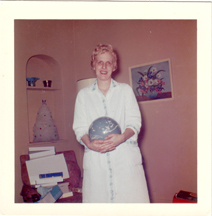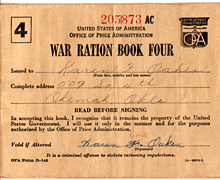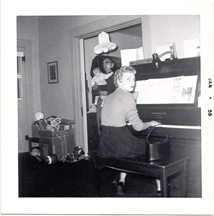Another in an ongoing series of posts celebrating the life of our mother:
Our parents were never stuffy—not in the least—but still, some of the stories of their early years together are a little hard to imagine.
We mentioned in an earlier installment of The Karen Files that Karen and Lloyd, for two or three years in a row, operated a temporary fireworks stand with our neighbors and friends, the Youngs.
As we said in that previous post, that scenario puts us in a mind of a never-produced I Love Lucy script in which Lucy convinces Ricky and the Mertzes that selling fireworks is the way to quick and easy riches.
But then, truth be told, we always experienced a sort of transference when watching I Love Lucy (in reruns only, mind you—we’re not that old—though those reruns were ubiquitous in our childhood). We felt, in an odd way, as if we were watching the early years of our parents’ marriage when we watched Lucy and Ricky’s misadventures.
 Hi-res version |
Not that Lloyd is Cuban (he was born and raised in Oklahoma; still lives there today) or musical (take our word for it—or ask him to sing “Wake Up, Little Suzie,” if you don’t believe us). Nor was Karen a dizzy dame ala Lucy. And theirs was a very equal partnership—it was not the patriarchy that the Ricardo household was.
But Lloyd did have dark, curly hair in those days, piled high as was Ricky’s. And though Karen may have been far less dizzy than Lucy, she was no less fun or sassy.
Still, despite our childish tendency toward conflating the Ricardos with the Leveridges, it’s still hard to imagine our folks operating a roadside fireworks stand. It’s equally hard to imagine them smoking (which we can faintly remember them doing just that—Karen gave up her Kools in the early-to-mid-’60s, and Lloyd, who was always more of a cigar guy, though only at the office, gave up his Swisher Sweets in the early ’70s).
And it’s hard. too, to imagine them in a bowling league. Again, our parents were not snobs, and though their financial circumstances rose and fell with the passing years and the tides of fortune, they were not, strictly speaking, blue-collar workers (Karen did work the night shift at the newspaper for a time in their salad days, though for most of our childhood, she was a homemaker, and as the owner of an automobile dealership, Lloyd came home with grease under fingernails after many a 12-hour day).
Still, the Honeymooners, they were not. But for a while, they did both go in for bowling. The late ’50s and early ’60s were, it seems to us—we have no evidence whatsoever to back this up—the heyday of bowling in the U.S., and if that’s so, it’s not surprising two young marrieds like Lloyd and Karen would want to join in the fun.
We have no memory of having seen either of them in action at a bowling alley, but we do recall encountering, stashed in the back of their closets, those small pieces of luggage that held their bowling balls. We recognize and remember quite well the robin’s-egg blue of Mom’s bowling ball, as seen in the above photo.
We’re guessing this picture was taken in 1959 or ’60. It’s clearly Christmas time, and Mom seems pleased as punch as she shows off her new ball. We remember well, too, the homemade Christmas decoration in the background, a Christmas tree made of a round wooden disc for a base, a wooden dowel rod inserted into it, and layer after layer of decorative netting slid down upon the rod, each a bit smaller in circumference than the one below it. Tiny balls are then attached to the netting and a small cardboard angel placed atop the dowel rod to complete the Christmas tree effect.
We like imagining Lloyd and Karen at 66 Bowl, enjoying a burger, an ice-cold Jax beer and even the occasional smoke, while competing for a league championship at the local lanes.





